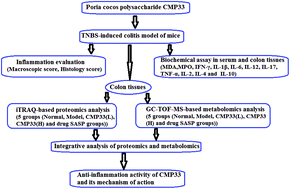当前位置:
X-MOL 学术
›
Food Funct.
›
论文详情
Our official English website, www.x-mol.net, welcomes your
feedback! (Note: you will need to create a separate account there.)
The protective effects of Poria cocos-derived polysaccharide CMP33 against IBD in mice and its molecular mechanism†
Food & Function ( IF 5.1 ) Pub Date : 2018-10-08 00:00:00 , DOI: 10.1039/c8fo01604f Xiaofei Liu 1, 2, 3, 4 , Xiuting Yu 3, 4, 5, 6 , Xiaofei Xu 1, 2, 3, 4 , Xiaojun Zhang 3, 4, 6, 7 , Xuewu Zhang 1, 2, 3, 4
Food & Function ( IF 5.1 ) Pub Date : 2018-10-08 00:00:00 , DOI: 10.1039/c8fo01604f Xiaofei Liu 1, 2, 3, 4 , Xiuting Yu 3, 4, 5, 6 , Xiaofei Xu 1, 2, 3, 4 , Xiaojun Zhang 3, 4, 6, 7 , Xuewu Zhang 1, 2, 3, 4
Affiliation

|
In this study, the protective effects of a carboxymethyl polysaccharide CMP33 from Poria cocos against inflammatory bowel disease (IBD) were investigated using TNBS-induced colitis in mice. The results showed that CMP33 markedly ameliorated the severity of colitis, including a 2-fold decrease in the mortality rate, a 50% decrease in disease activity index, and a 36%–44% decrease in macro- or microscopic histopathological score, compared with TNBS administration. Moreover, CMP33 decreased the levels of pro-inflammatory cytokines and increased the levels of anti-inflammatory cytokines in the colon tissue and serum of colitic mice. Using iTRAQ-coupled- nano-HPLC-MS/MS-based proteomics, the protein profiles after TNBS, high- or low-dose CMP33 and salazosulfapyridine (SASP) treatments were compared and many differentially expressed proteins were identified. Among them, 7 proteins (Hmgcs2, Fabp2, Hp, B4galnt2, B3gnt6, Sap and Ca1) were proposed to be the common targeting protein group (TPG) of CMP33 and drug SASP. Particularly, some targeting proteins were CMP33-dose-specific: high-dose-specific TPG (Mtco3, Gal-6, Mptx, S100 g and Hpx) and low-dose-specific TPG (Zg16, Hexb, Insl5, Cept1, Hspb6 and Ifi27l2b), suggesting the complex acting mechanism of CMP33. GC-TOF-MS-based metabolomics revealed that oleic acid and dihydrotestosterone could be the common targets of CMP33 and SASP. By integrative analysis of proteomics and metabolomics, key protein–metabolite pathways (PMP) were identified, PMP for high-dose: 2-hydroxybutyric acid – (GPT, GGH) – glutathione – ALB – testosterone – TTR – dihydrotestosterone; PMP for low-dose: (PYY, FABP2, HMGCS2) – oleic acid – TTR – dihydrotestosterone. In total, these results demonstrated the protective effects of CMP33 against IBD in mice through the potential TPG and PMP.
中文翻译:

ia衍生多糖CMP33对小鼠IBD的保护作用及其分子机制†
在这项研究中,使用TNBS诱导的结肠炎,研究了来自Por(Poria cocos)的羧甲基多糖CMP33对炎性肠病(IBD)的保护作用。结果表明,与之相比,CMP33明显改善了结肠炎的严重性,包括死亡率降低了2倍,疾病活动指数降低了50%,宏观或微观组织病理学评分降低了36%–44%。 TNBS管理。此外,CMP33降低了结肠炎小鼠结肠组织和血清中促炎细胞因子的水平,并提高了抗炎细胞因子的水平。使用基于iTRAQ偶联的纳米HPLC-MS / MS的蛋白质组学,TNBS后的蛋白质谱 比较了高剂量或低剂量CMP33和Salazosulfapyridine(SASP)的治疗方法,并鉴定了许多差异表达的蛋白质。其中,有7种蛋白(Hmgcs2,Fabp2,Hp,B4galnt2,B3gnt6,Sap和Ca1)被提议作为CMP33和药物SASP的共同靶向蛋白组(TPG)。特别地,一些靶向蛋白是CMP33剂量特异性的:高剂量特异性TPG(Mtco3,Gal-6,Mptx,S100 g和Hpx)和低剂量特异性TPG(Zg16,Hexb,Insl5,Cept1,Hspb6和Ifi27l2b),提示了CMP33的复杂作用机制。基于GC-TOF-MS的代谢组学研究表明,油酸和二氢睾丸激素可能是CMP33和SASP的共同靶标。通过蛋白质组学和代谢组学的综合分析,确定了关键的蛋白质-代谢途径(PMP),即大剂量的PMP:2-羟基丁酸-(GPT,GGH)–谷胱甘肽– ALB –睾丸激素– TTR –二氢睾丸激素;低剂量PMP:(PYY,FABP2,HMGCS2)–油酸– TTR –二氢睾酮。总体而言,这些结果证明了CMP33通过潜在的TPG和PMP对小鼠IBD的保护作用。
更新日期:2018-10-08
中文翻译:

ia衍生多糖CMP33对小鼠IBD的保护作用及其分子机制†
在这项研究中,使用TNBS诱导的结肠炎,研究了来自Por(Poria cocos)的羧甲基多糖CMP33对炎性肠病(IBD)的保护作用。结果表明,与之相比,CMP33明显改善了结肠炎的严重性,包括死亡率降低了2倍,疾病活动指数降低了50%,宏观或微观组织病理学评分降低了36%–44%。 TNBS管理。此外,CMP33降低了结肠炎小鼠结肠组织和血清中促炎细胞因子的水平,并提高了抗炎细胞因子的水平。使用基于iTRAQ偶联的纳米HPLC-MS / MS的蛋白质组学,TNBS后的蛋白质谱 比较了高剂量或低剂量CMP33和Salazosulfapyridine(SASP)的治疗方法,并鉴定了许多差异表达的蛋白质。其中,有7种蛋白(Hmgcs2,Fabp2,Hp,B4galnt2,B3gnt6,Sap和Ca1)被提议作为CMP33和药物SASP的共同靶向蛋白组(TPG)。特别地,一些靶向蛋白是CMP33剂量特异性的:高剂量特异性TPG(Mtco3,Gal-6,Mptx,S100 g和Hpx)和低剂量特异性TPG(Zg16,Hexb,Insl5,Cept1,Hspb6和Ifi27l2b),提示了CMP33的复杂作用机制。基于GC-TOF-MS的代谢组学研究表明,油酸和二氢睾丸激素可能是CMP33和SASP的共同靶标。通过蛋白质组学和代谢组学的综合分析,确定了关键的蛋白质-代谢途径(PMP),即大剂量的PMP:2-羟基丁酸-(GPT,GGH)–谷胱甘肽– ALB –睾丸激素– TTR –二氢睾丸激素;低剂量PMP:(PYY,FABP2,HMGCS2)–油酸– TTR –二氢睾酮。总体而言,这些结果证明了CMP33通过潜在的TPG和PMP对小鼠IBD的保护作用。











































 京公网安备 11010802027423号
京公网安备 11010802027423号